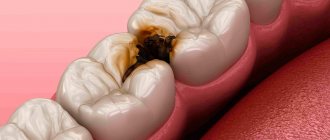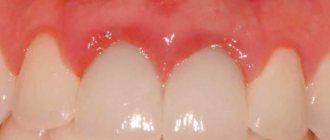The diagnosis of “wedge-shaped dental defect” is associated in most patients with a wedge-shaped depression at the base of the tooth. But not every cervical defect is wedge-shaped. Moreover, the disease refers to non-carious lesions that require a special approach to treatment. In the “Smile Factor”, the doctor will identify the prerequisites for the formation of such defects, and if the integrity of the dental tissues is already compromised, he will conduct a thorough diagnostic search and restore the tooth using modern techniques.
What is a wedge-shaped tooth defect - how to cure it
In dentistry, patients often encounter various forms of non-carious lesions of hard dental tissues. One of these disorders is cervical erosion (wedge-shaped defect). It leads to a deterioration in the aesthetics of the dentition and an increase in the sensitivity of the affected segment. What to do if a wedge-shaped defect appears? The pathology can be eliminated at the aesthetic dentistry center near Otradnoe metro station in Moscow. We provide all types of dental services using high-quality materials and modern technologies.
Reasons for the development of pathology
There are many reasons for the appearance of a wedge-shaped defect. Among them
- Aggressive tooth brushing. We are talking about excessive pressure on the teeth, chaotic movement of the toothbrush. For daily care, the brush should be directed from top to bottom using soft scrubbing or circular movements. If you rub your teeth horizontally, you injure the enamel. Do not use brushes with hard bristles.
- Exposure to acids that come from food. Their suppliers are citrus juices and soda. Acid disrupts the natural protection of teeth and the enamel wears off faster when brushing your teeth or chewing food.
- Malocclusion. In this case, the load between the teeth is distributed incorrectly and additional pressure falls on the area of the transition of the crown to the root of the teeth. Additional risk factors are bruxism (teeth grinding), dystonia of the masticatory muscles, and dental defects.
- Frequent teeth whitening. Enamel is destroyed not only by uncontrolled home bleaching with lemon juice, soda and improvised abrasive substances, but by professional procedures if carried out more often than 1-2 times a year. To avoid becoming the owner of tooth enamel wearing away in the cervical area, replace frequent whitening with remineralization and fluoridation. Whitening pastes should also not be used constantly. They work great in courses lasting no more than 30 days, 1-2 times a year.
- Gastrointestinal diseases and hormonal imbalance. Increased stomach acidity can weaken the enamel and lead to the formation of a wedge-shaped defect. Women over 40 years of age are also at risk - hormonal changes lead to calcium leaching.
- Gum diseases. With periodontitis and periodontal disease, the necks of the teeth are exposed and their thin enamel is destroyed by acids and plaque bacteria.
- Alcohol abuse and smoking. Alcoholic drinks and tobacco smoke are aggressive to the microflora of the mouth. This leads to demineralization and tooth decay.
- Frequent consumption of solid foods.
- Incorrect treatment by an orthodontist.
- Heredity.
- Chemotherapy in the treatment of cancer.
What is a wedge-shaped dental defect?
A wedge-shaped defect (abfraction, cervical erosion, stress corrosion, etc.) is a pathological loss of tissue, shaped like a wedge, the tip of which is directed towards the pulp. Pathology is more common in middle and old age, although initial manifestations are also found in young people.
This slowly progressing disease leads to a significant loss of hard dental tissues, as a result of which the sensitivity of enamel and dentin increases, and dystrophic changes in the pulp appear. The pathogenesis is not fully understood. The most famous theories of the development mechanism:
- Mechanical. Tissue destruction is associated with traumatic injury from careless or improper brushing.
- Chemical. Erosion occurs due to the leaching of minerals due to the aggressive action of acids entering the body with food, or formed during fermentation of food residues that are deposited near the neck of the segments.
- Occlusal. Associated with primary destructive processes. Thinning of tissues can occur due to traumatic occlusal stress on the enamel, leading to breaks in its molecular bonds.
Why wedges form on teeth and what to do about it
The defect can develop on both the upper and lower jaw, on one or more teeth. Most often, canines and premolars are affected - namely, they experience a large chewing load. The disease develops gradually and unnoticed. Over time, the defect deepens into the dentin, and the person feels pain. If the problem continues to be ignored, the base of the tooth becomes so thin that it can break.
A wedge-shaped defect appears in people of different ages, including teenagers. However, the older the person, the greater the risk of developing pathology.
The moment of appearance of the wedge-shaped defect cannot be tracked independently. But if you undergo regular examinations with a dentist, treatment will begin on time and will be completed with minimal time and money.
At first glance, a wedge-shaped defect can be confused with cervical caries. The affected teeth are marked with triangular-shaped spots and depressions, up to 4 mm in depth in the acute stage of development.
As for where wedges on teeth come from, there are three generally accepted theories:
- Chemical. The culprit is aggressive acids from food, drinks and resulting from an imbalance in the acid balance of the oral cavity.
- Mechanical. The defect is caused by an external load.
- Physico-mechanical. Pathology develops in response to improper chewing load.
What does a wedge-shaped tooth defect look like?
Damaged teeth have a characteristic appearance: the area where the segment enters the gum is thinned and has a V-shape
y form. The color of the affected area is darker than the rest of the enamel. You can clearly see what the wedge-shaped effect looks like in the photographs.
If you discover a similar defect in yourself, do not delay treatment. The initial stages of the disease are easier to eliminate than deep pathology. The doctors of our aesthetic ]dentistry in Moscow[/anchor] near the Otradnoe metro station will help you cope with the problem. The cost of treating wedge-shaped defects depends on the depth of the segment damage.
Treatment of initial caries at the Family Dentist clinic
During the initial examination, I and our other doctors determine the presence or absence of pathological changes and suggest procedures. If treatment is not needed at this stage, you will receive information about dental health, recommendations on nutrition, hygiene, and taking mineral complexes. We do not offer unnecessary additional services. When treating caries in the spot stage, the loss of minerals is compensated and hard tissue is preserved. Mineral ions restore the crystal lattice, reducing the permeability of the enamel.
Stages of development of a wedge-shaped defect
| Stage | Description |
| I (initial manifestations) | Primary deformations are not visible without special tools. The presence of destruction can be suspected by the disappearance of the natural shine of the surface near the gum’s contact with the unit. |
| II (superficial) | The shortcoming becomes noticeable. The damaged area is rough to the touch and has a small depression (about 0.2 mm). Hyperesthesia may occur. |
| III (medium) | The pathological sensitivity of the segment increases, the size of the depression increases to 0.3 mm (with a length of up to 0.4 cm). Its shape becomes like a wedge. |
| IV (deep erosion) | Serious thinning of the cervical zone (over 4 - 5 mm). Dentin and pulp are involved in the process. There is gum recession and root exposure. |
In the thinned area, crown fracture may occur. If a complication occurs, seek help from the North-Eastern Dental Center No. 1, where you can undergo treatment for pulpitis and other adverse outcomes of the wedge-shaped defect.
Early treatment
Mineral deficiency appears gradually. The crystals dissolve faster than the enamel absorbs minerals from food. First, the pearly shine disappears, the surface becomes rough, matte demineralized areas appear, and the permeability of the enamel increases. As long as the enamel layer is not destroyed, the carious process is reversible . Caries in the white spot stage is eliminated without tooth preparation after a course of remineralization.
I want to please you: if the disease is diagnosed early, teeth are not drilled. To prevent further destruction of the enamel layer, the mineral composition is restored. Remineralizing therapy (saturation of hard dental tissues with calcium, phosphorus, fluorine) prevents the development of caries.
How to treat the disease
The tactics for treating wedge-shaped tooth defects depends on the degree of its severity. The doctor will assess the condition of the enamel, do sensitivity tests, and, if necessary, send it for x-ray diagnostics. According to the examination results, one of the following treatment protocols will be selected to correct the deficiency: remineralization, filling, veneer installation, prosthetics.
Enamel remineralization
The method is effective for superficial disorders. It consists of professional hygienic cleaning of teeth during which layers of stones and soft plaque are removed from their surface. To accomplish the task, different methods are used: Air Flow, mechanical cleaning with hand tools, laser, etc. At the end of the procedure, mineralizing agents are applied to the surface of the segments (by application or using the electrophoresis method). To eliminate the problem, 12–20 procedures will be required.
Sealing
The technology is used for stage III-IV disorders. It consists of eliminating the defect using composite light-curing materials (fillings). The condition for using the method is the initial elimination of the pathological process that caused the development of wedge-shaped destruction (bruxism, malocclusion, etc.). Otherwise, filling may be ineffective.
Veneer installation
A veneer is a ceramic covering on a damaged tooth. At the preliminary stage, remineralization or filling of the defect is carried out. The technique of performing the procedure consists of partial grinding of the frontal surface of the deformed unit, and subsequent fixation of a thin ceramic plate onto it using special dental cement. Veneers are made in an orthopedic laboratory.
Prosthetics
This is a method of restoring a destroyed segment with an orthopedic crown. The indication for this type of treatment is extensive tooth damage. The installed crown must completely cover the visible defect. The required effect is not achieved in all cases (if the tooth damage is deep and extensive). In such a situation, the doctor may suggest dental implantation.
If left untreated, the wedge-shaped defect constantly progresses, as a result of which the segment is destroyed and may be lost. The correct choice of hygienic oral care products and timely consultation with a doctor when the first signs of pathology appear will help prevent the problem.
Should I go to the dentist?
Recently, my old friend from Rogachev (the city where I grew up) called me and said that her husband had a white spot on his tooth. I advised her husband to go to the dentist. “Or maybe I should just brush my teeth better and the stain will go away on its own? Or maybe there is some gel that can be used at home?” she doubted. Unfortunately, brushing your teeth, even the most thorough, will no longer help during the staining phase. As an additional prevention, you can use remineralizing gels. They enrich tooth enamel with minerals and protect teeth from acids. But I strongly recommend that you consult a dentist who can help you choose the right remineralizing agent for you.
Make an appointment +375 29 604-61-61
Stages of remineralizing therapy:
- Professional oral hygiene. I remove biofilm and tartar, grind and polish the enamel. After professional cleaning, less bacteria accumulate on a smooth surface, the risk of caries and gum inflammation is reduced, and your smile becomes beautiful.
- I treat the affected teeth with products containing active fluoride and calcium, choosing the drug depending on the depletion of the enamel.
- I give recommendations on the use of specialized toothpastes and fluoride-containing products.
- To assess the effectiveness of treatment and the quality of hygiene, I schedule an appointment after 2-3 months.
The good news is that early caries can be easily treated, and most importantly, without a drill. Without treatment, a cavity forms and the deep layers of dentin become infected. If you ignore this stage, pulpitis, periodontitis, and granuloma develop, which can lead to tooth loss. The more extensive the destruction of hard tissues, the more difficult and expensive the treatment; in extreme cases, the need for prosthetics and implantation arises.
What you can do at home
We described the features of caries treatment at different stages in the dentist's office. Many people are interested in the question of what to do if the disease develops at home, whether it can be stopped on their own. The only thing available to the patient is prevention. If a carious lesion has already begun, it is impossible to reverse it with the help of rinses or folk remedies.
However, you can slow it down or stop it if you follow a number of simple rules:
- brush your teeth twice a day and rinse your mouth after eating;
- give up sweet foods and sodas;
- quit bad habits, in particular smoking;
- use irrigators to clean the oral cavity.
In addition, do not forget to check your teeth every six months, even if you are not worried about caries symptoms.
Prevention of the development of dental anomalies
Anomalies in the shape of teeth are an irreversible process, but complex treatment makes it possible to eliminate deviations, recreate the correct anatomical shape of teeth, restore the functioning of the dental system and improve the appearance of teeth.
Prevention of the development of abnormalities in the shape of teeth is to ensure the normal development of the child inside the womb, as well as providing care and maintaining his health.
Preventive measures are aimed at ensuring a balanced diet, timely correction of endocrine system disorders and treatment of infectious and chronic diseases. We advise you to regularly visit your dentist for the prevention and timely diagnosis of dental development disorders.
What causes a black hole to form in a tooth?
The main reason for the formation of holes in teeth, as already mentioned, is caries. Being a consequence of the activity of bacteria and microorganisms, it can lead to complete destruction of the tooth. Doctors note that there are many reasons for its appearance.
Important! According to statistics, women suffer from caries more often than men. This is associated with hormonal changes in the body that occur in women during pregnancy and lactation. In addition, people with malocclusions are more likely to develop cavities and holes in their teeth. Too narrow spaces between teeth, thinned enamel - all this contributes to the accumulation of food and the creation of a favorable environment for the development of microorganisms.
How is cervical caries diagnosed?
If the carious lesion is localized on the visible part of the tooth, the doctor makes a diagnosis after an external examination. But to confirm it, a special test is performed using a dye solution. It is applied to the enamel and left for 3-4 minutes. The affected area turns blue. After a few hours, the dye is completely washed out of the mouth.
The doctor may also prescribe an x-ray to assess the nature of the spread of caries, the depth of the carious cavity, the condition of the nerve endings, etc. Based on the results of the examination, a treatment method is selected. It is determined, first of all, by the stage of the disease.











